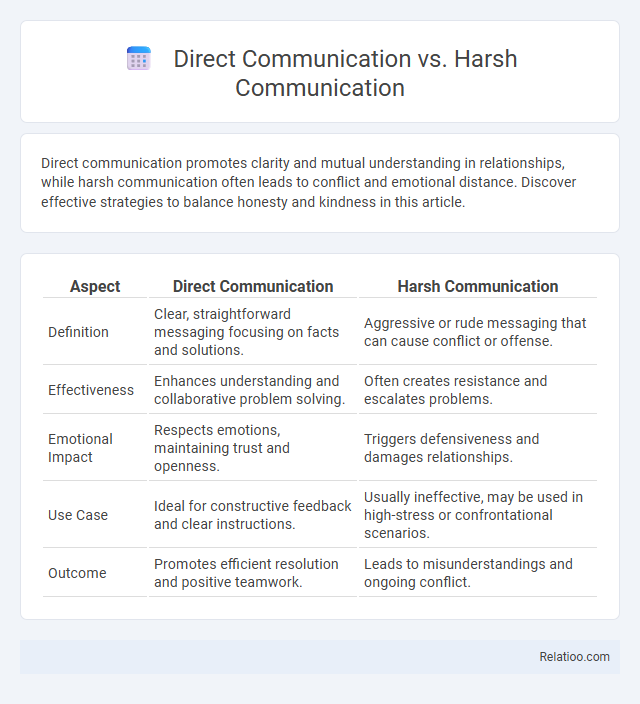Direct communication promotes clarity and mutual understanding in relationships, while harsh communication often leads to conflict and emotional distance. Discover effective strategies to balance honesty and kindness in this article.
Table of Comparison
| Aspect | Direct Communication | Harsh Communication |
|---|---|---|
| Definition | Clear, straightforward messaging focusing on facts and solutions. | Aggressive or rude messaging that can cause conflict or offense. |
| Effectiveness | Enhances understanding and collaborative problem solving. | Often creates resistance and escalates problems. |
| Emotional Impact | Respects emotions, maintaining trust and openness. | Triggers defensiveness and damages relationships. |
| Use Case | Ideal for constructive feedback and clear instructions. | Usually ineffective, may be used in high-stress or confrontational scenarios. |
| Outcome | Promotes efficient resolution and positive teamwork. | Leads to misunderstandings and ongoing conflict. |
Understanding Direct Communication
Direct communication involves expressing thoughts and feelings clearly and respectfully without ambiguity, fostering transparency and efficient information exchange. Harsh communication, however, combines bluntness with negativity or aggression, often causing misunderstandings and emotional harm. Understanding direct communication requires distinguishing it from harshness by emphasizing clarity and respect rather than criticism or hostility.
Defining Harsh Communication
Harsh communication involves delivering messages in a way that can be perceived as aggressive, insensitive, or overly critical, often damaging relationships and trust. Unlike direct communication, which values clarity and honesty without offensiveness, harsh communication prioritizes bluntness at the cost of emotional impact. Understanding Your communication style helps avoid harshness and fosters more effective, respectful interactions.
Key Differences Between Direct and Harsh Communication
Direct communication involves clear, straightforward expression of thoughts and feelings while maintaining respect and empathy, fostering effective understanding. Harsh communication, by contrast, includes aggressive tone, judgmental language, or emotional insensitivity, often causing conflict and emotional distress. The key difference lies in intent and delivery: direct communication prioritizes clarity and respect, whereas harsh communication undermines relationships through negativity and disrespect.
Benefits of Direct Communication
Direct communication fosters clarity and efficiency by conveying messages in a straightforward manner, reducing misunderstandings and enhancing collaboration. Unlike harsh communication, directness maintains respect and professionalism without resorting to negativity or aggression. Embracing direct communication improves workplace morale, encourages open dialogue, and supports problem-solving through transparent and honest interactions.
Negative Effects of Harsh Communication
Harsh communication often leads to decreased morale, increased stress levels, and damaged relationships within teams, negatively impacting overall productivity. Unlike direct communication, which values clarity and respect, harsh communication involves aggressive tones or language that can cause resentment and miscommunication. Your ability to foster a positive environment diminishes significantly when harshness replaces constructive dialogue.
How to Practice Direct Communication Effectively
Practicing direct communication effectively requires clarity, respect, and empathy to ensure your message is understood without causing offense. Focus on expressing your thoughts honestly while maintaining a tone that is firm but non-aggressive, avoiding the pitfalls of harsh communication that can damage relationships. You can enhance your communication skills by actively listening, using precise language, and being mindful of your body language to convey openness and sincerity.
Signs Your Communication Is Becoming Harsh
Recognizing signs your communication is becoming harsh includes a noticeable rise in sarcasm, abrupt tone, and cutting remarks that undermine clarity and respect. Harsh communication often involves blaming language and emotional outbursts, which can erode trust and hinder effective dialogue. Direct communication, by contrast, remains clear and assertive without crossing into negativity, helping you maintain constructive and respectful interactions.
The Role of Emotional Intelligence in Communication
Effective communication relies heavily on emotional intelligence, which enables you to express your thoughts directly without causing offense. Direct communication fosters clarity and understanding, while harsh communication often triggers defensiveness and damages relationships due to unregulated emotions. Developing emotional intelligence helps in recognizing and managing emotional responses, thereby reducing harshness and promoting more empathetic and constructive interactions.
Strategies to Shift from Harsh to Direct Communication
Shifting from harsh to direct communication involves adopting clear, concise language while maintaining respect and empathy, which enhances understanding and reduces conflict. Strategies include focusing on facts rather than emotions, using "I" statements to express personal perspectives without blame, and actively listening to validate the other party's viewpoint. Training in emotional intelligence and practicing mindfulness also help individuals recognize and control harsh tones, fostering a more productive and positive dialogue.
Building Healthy Communication in Relationships
Building healthy communication in relationships involves distinguishing direct communication from harsh communication and outright harshness. Direct communication conveys your thoughts clearly and respectfully, promoting understanding and trust, while harsh communication often includes aggressive tones or insensitive language that can damage emotional connections. Avoiding harshness and fostering empathy ensures your interactions strengthen bonds rather than create conflict.

Infographic: Direct Communication vs Harsh Communication
 relatioo.com
relatioo.com